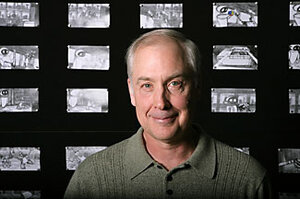Sounding out character in movies
Movie sound design proves more art than science.

Ben burtt: Creator of the voice of R2D2 in ‘Star Wars,’ the sound designer describes his job as ‘audio puppeteering.’
Courtesy of Pixar
For all the computing power that animators employ these days, sometimes it's a simple sound that conveys the most emotion. Pixar's hit movie, "WALL-E," is the most recent example of sound's crucial role. The first hour of the intergalactic love story has almost no human dialogue. Instead, the story line starts with simple bleeps, squeaks, and background atmospherics, which, by the end of the film, become a sophisticated interweaving of 2,600 sounds.
The orchestrator of this symphony is Ben Burtt, who, with his team, found everyday sounds they could alter to create each mood. Making a robot "come alive" on screen takes clarity on the part of both animators and sound designers. "It's about understanding if the sound should be happy or sad, sympathetic or mechanical," says Mr. Burtt from his office in Nicasio, Calif. That way, every time the character WALL-E moves his arm, turns around, or "speaks," his sounds consistently reinforce his kind, industrious, and ever-hopeful nature.
Despite the fact that animated films are largely special effects, creating the character voices for "WALL-E" did not originate with an electronic synthesizer. Burtt recorded human voices for the robots and converted them electronically to fit the focus of each scene. He would then play them for director and co-writer Andrew Stanton to be sure they were true to his vision of the characters' identities.
The collaborative nature of this animated film was more intense than working on the live-action "Indiana Jones and the Kingdom of the Crystal Skull," says Academy Award-winner Burtt, who also created the voice of R2D2 in "Star Wars." "If there's one thing you learn at Pixar," he says, "it's that every animator is an actor. So when the creative team got together, the animators all spoke in funny voices and acted out the characters' personas. My job consisted of what I call 'audio puppeteering' – pulling the strings to make the character come to life audibly. So when I saw the movements of the animators, I understood better how the characters should sound."
Burtt's career started the same way. As a boy, he'd act out movements to the classical music his mother enjoyed. Then he became fascinated with sounds on television shows and movies, such as "20,000 Leagues Under the Sea." "I'd record favorite sounds and when I played them back, the whole drama came to mind. Then I saw Walt Disney's 'Fantasia.' " Burtt says the film's colorful movements, displayed in sync with Bach's "Toccata and Fugue in D Minor" helped him understand visually how sound could initiate movement. Then he put it all together, making adventure films with friends using his dad's home-movie camera.
It was not until 1979 and the release of "Apocalypse Now" that the term "sound designer" was coined by Walter Murch, who created sound for the film. Prior to then, and with the exception of the genius of Alfred Hitchcock, Orson Wells, and a few others, movie sound was often an afterthought, plugged in between and under dialogue after filming was completed.
Randy Thom, sound designer for "Horton Hears a Who," "Ratatouille," and "The Polar Express," recalls, "Walter taught me the importance of sound in every aspect of life. The first sense active in a baby, before it's even born, is the sound of its mother's heartbeat, stomach, and voice," he says from his office at Skywalker Sound, north of San Francisco.
"It's all about listening," Mr. Thom adds, referring to the need to understand the director's artistic vision. "Walter taught me the importance of meeting with the director before shooting begins, so we can determine if the environment of the film is noisy or quiet, sinister or banal. Just because you have a script doesn't mean you know how a movie is supposed to sound."
Movie sound gained a new dimension with George Lucas, the creative force behind the "Star Wars" saga, when he articulated the need for organic or "real world" sound. For years movie sound was designed to be flawless. But Mr. Lucas recognized that movies could be more engaging by using everyday sound, instead of studio-perfect effects. "Ben Burtt took and ran with this idea," says Thom.
When Burtt was hired to collect sounds for "Star Wars" while a graduate film student at the University of Southern California, he recorded noises made by TV sets, vacuum cleaners, and howling bears among other things. These were modulated, amplified, and later became the sounds of laser swords, land rovers, and Chewbacca's "Wookie" voice. As for R2D2, it was his beeps and squeaks that helped moviegoers relate to the softer side of the sci-fi epic.
